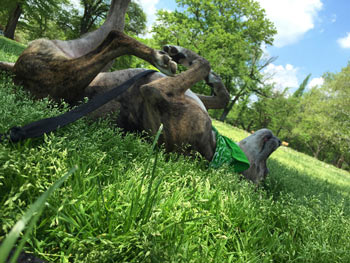How to Find Ticks on Your Dog

Beyond being just plain icky, ticks can be dangerous. They can transmit diseases to both humans and dogs. Mild winters and development into more rural areas have been leading many veterinarians to notice an increase in tick-borne diseases as well as certain types of ticks in areas that they didn't previously inhabit (Rocheleau, 2016). You can read more about this in our article, "Watch Out for Ticks This Year."
For all of these reasons, it's important to know how to find ticks on your dog.
How to Look for Ticks on Your Dog
Ticks can be pretty small, and they're harder to find on long-haired dogs and those with thick undercoats. Running your fingers through your dog's fur, feeling all over for small bumps is a good way to find ticks. Getting under the fur, right to the skin, and moving your fingers against the direction that the hair is growing works best.
You can also use a fine-toothed comb or flea comb to gently push the fur back, looking at your dog's skin for any brown, green, gray, or black bumps. As ticks feed, they become larger, but they are sometimes easy to mistake for a wart or other skin lesion. If you suspect a tick, gently run the comb all along its edge to see if it lifts away from the skin. A tick's mouthpieces will be attached to your dog's body, but the rear end and legs will be free, so if the bump isn't attached all the way around or you see legs moving, you've probably found a tick.
Where to Look for Ticks on Your Dog
A tick can attach itself anywhere on your dog, but there are some spots that seem to entice them more than others. Take a look in these areas first. They include:
- Around the eyes.
- Around or inside of the ears.
- In the armpits or groin.
- Between the toes.
- At the base of the ears, on the neck.
- Under the tail, around the anus or vulva.
- In any skin folds.
When Should You Look for Ticks on Your Dog?
Whenever your dog is outside during the spring, summer, or fall in your area, you should check for ticks daily. This is especially true if your dog has been in tall grass or in a rural park or trail.
It takes ticks 24-48 hours, on average, to transmit disease-causing organisms to a dog after they attach, so checking and removing ticks daily can greatly reduce the risk of your dog contracting these illnesses. Don't forget to check yourself and your children for ticks daily, as well.
How to Remove Ticks on Your Dog
It's important not to traumatize the tick while you are removing it from your dog. Doing so can cause it to rapidly release contents of its body, including disease-causing organisms, into your pet. Using tweezers or a tick removal tool, grasp the tick as close to your dog's body as you can and pull straight out with firm pressure. Don't use a twisting motion and don't jerk.
Don't put anything on the tick to try and make it release; these things generally don't work and can cause the tick to become stressed and release substances into the dog. Don't squish the tick with your fingers because that might expose you to disease-causing organisms. Place the removed tick in rubbing alcohol until it is dead.
Tick Preventatives
Because of the large variety in the types of ticks that can affect dogs, preventatives may have a challenging time completely repelling ticks, especially if your dog is in an area with lots of them. However, there are many good products that can drastically reduce or eliminate the number of ticks that are able to attach to your dog for a long enough period of time to transmit illness. Check with your veterinarian for recommendations for your specific dog and area.
Works Cited
- Rocheleau, M. (2016, March 31). Our canine friends also need to watch out for ticks. Retrieved from BostonGlobe.com.
You May Also Like These Articles:
Black Widow Spider Bites in Dogs
How to Avoid Expensive Veterinary Bills for Your Dog
Dog Park Preparation Tips - Slideshow
Lick Granuloma: Causes, Treatments, and Prevention of Acral Lick Granuloma in Dogs
Disclaimer: This website is not intended to replace professional consultation, diagnosis, or treatment by a licensed veterinarian. If you require any veterinary related advice, contact your veterinarian promptly. Information at DogHealth.com is exclusively of a general reference nature. Do not disregard veterinary advice or delay treatment as a result of accessing information at this site. Just Answer is an external service not affiliated with DogHealth.com.
Notice: Ask-a-Vet is an affiliated service for those who wish to speak with a veterinary professional about their pet's specific condition. Initially, a bot will ask questions to determine the general nature of your concern. Then, you will be transferred to a human. There is a charge for the service if you choose to connect to a veterinarian. Ask-a-Vet is not manned by the staff or owners of DogHealth.com, and the advice given should not delay or replace a visit to your veterinarian.



